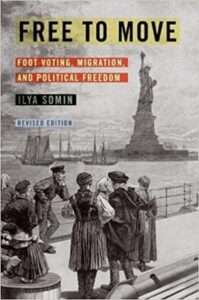

The revised edition of my book Free to Move: Foot Voting, Migration, and Political Freedom comes out on December 1. This is the third in a series of posts on new issues included in this edition, that weren’t in the original. Previous posts provided a brief overview of the book, and considered the issue of pandemic migration restrictions intended to curb the spread of disease.
This post looks at the implications of widespread remote work for foot voting. Like pandemic migration restrictions, this issue came to my (and many others’) attention because of the Covid-19 pandemic. The spread of the virus led to a vast expansion of remote work that might, at least in part, persist even after the pandemic wanes.
An October 2020 Pew Research Center survey found that the percentage of American workers doing their jobs all or mostly at home had risen from about 7.6% before the pandemic to 27% as of the time of the survey.
In one crucial sense, remote work can greatly reduce moving costs, thereby greatly expanding foot voting opportunities. By separating work from place of residence, remote work enables more people to move without giving up their current jobs. For example, an accountant, lawyer, or computer programmer employed by a New York City firm could move to Kansas, while still continuing to work for the same employer. For many, that could greatly reduce to cost of moving to a location with government policies that better fit their preferences. If the New Yorker prefers Kansas’ more conservative policies on crime, education, or government spending, she can act on that preference more easily. The same goes for a Kansan who wishes to move to a more liberal jurisdiction.
At the same time, however, remote work might also reduce the value of foot voting options. Historically, much of the value of foot voting consisted in moving to jurisdictions whose policies foster better job opportunities, That advantage becomes less significant in a world where work is geographically separate from home.
On balance, remote work is likely to increase the value of foot voting opportunities much more than it decreases them. Much foot voting still involves government policies that are not directly about work, such as crime, housing costs, taxation, environmental quality, and many others. In addition, jurisdictions will still have incentives to foster favorable work environments for businesses and other employers, since the latter will have to still be located somewhere.
Despite the transformational potential of remote work, it is likely that job-related foot voting will remain important for a large majority of the world’s workers, at least for a long time to come. A November 2020 analysis by McKinsey & Co. concluded that only about 18-26% of jobs in the United States, Britain, Germany, Japan, France, and Spain can be done while working remotely three to five days per week. The figures ranged from a low of 18 percent for Spain to 22 percent for the US, and 26 percent for the United Kingdom. The vast majority of jobs in such fields as agriculture, personal services, household repair, and manufacturing, simply cannot be done remotely. Even many who can work remotely a high percentage of the time must still live relatively close to their workplaces if they need to come to the office as little as once or twice per week.
Future technological breakthroughs might make fully remote work more feasible for a wider range of employees in a wider variety of fields. It is difficult to predict to what extent this will happen, and how soon. But in-person work will remain essential for many millions of people on into the indefinite future.
Overall, remote work has expanded foot voting opportunities, and can potentially do so much more in the future. But we should be cautious about leaping to the conclusion that we will soon enter a world where most people can do their work online, without having to engage in in-person interactions with employers and customers on a regular basis.
In Chapter 5 of the book, I go into these issues in greater detail. I also consider the potential inequality in foot voting opportunities generated by remote work, in as much as it is likely to be more available to relatively affluent and high-skill employees more than to the working class.
The post What's New in the Revised Edition of "Free to Move," Part II: Implications of Remote Work for Foot Voting appeared first on Reason.com.
from Latest – Reason.com https://ift.tt/3xaHx94
via IFTTT